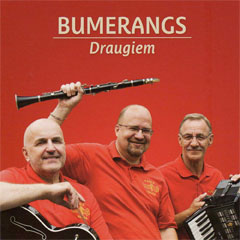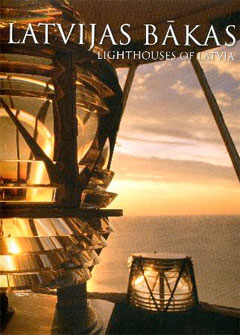
Bumerangs, from the northern Latvian city of Valka, has long been a Latvian schlager music institution. Celebrating its 25th anniversary in December 2011, the band has been one of the hardest working—playing, in some years, hundreds of concerts, and entertaining audiences not just in Latvia, but elsewhere in the world.
Oddly, though, the band’s recorded output has been minimal. 2010’s album Draugiem, is only its second compact disc, and was released a full decade after the last CD, 2000’s Agrāk un tagad.
However, the arrival of a new Bumerangs album, even if it does take 10 years to appear, is always a cause to celebrate, as the group—faithful to its traditional style and down-to-earth lyrics with a frequent dash of humor—always delivers a solid set of songs.
Much like Agrāk un tagad, the album Draugiem collects both songs newly written as well as songs that have been in the group’s repertoire for many years. The ensemble proves it still going strong, although it is now down to three members: Aivars Trēziņš providing vocals and playing the accordion, Vents Kraulis on vocals and clarinet, and Juris Skrajāns on vocals and guitars.
I would note that the absence of Edmunds Mednis, former Bumerangs drummer and vocalist, long since living in the United States (and performing with Ēriks Kīns as the duo Mednis un Kīns), is felt on this release. Mednis was a big part of the group’s sound, and did quite a bit of songwriting as well. However, in lieu of Mednis, Skrajāns takes on the bulk of the songwriting chores, and proves to be adept in his own right.
The members of Bumerangs offer advice and their own good natured philosophies in their songs. For example, “Pēdējā brīdī” is all about not leaving things to the last minute. “Dziesma draugiem,” an ode to friendship, includes the reassuring thought that no matter if one heads to heaven or to hell, friends will be waiting there.
Besides original songs, Bumerangs also has made a name by performing traditional songs in its own style. One of the band’s most beloved interpretations is of “Tev (Liepas satumst),” a popular Latvian song with lyrics taken from the poetry of Aleksandrs Čaks. This poignant and sad song is given a new dimension in the hands of Bumerangs, whose members give a memorable performance.
There is also the traditional “Vijolnieks,” a song about a poor violinist who loses the love of his his life to a rich man and expresses his deep sadness through his instrument. The tragedy of the song will leave an indelible mark on the listener, as Bumerangs has the unique ability to express the sadness of this song in a moving way.
Though being grounded in the schlager style, Bumerangs has always explored different musical styles and sounds. The song “Bumerangs,” about the discovery of the titular flying object, has a touch of reggae about it.
Though some of the songs are quite sad, there is always a positive spin. For example, “Tādi laiki” references the current economic difficulties, though the song is one of hope that “atkal jauna diena dzimst” (a new day is dawning). Of course, the listener will frequently encountered humor, such as the nuances of everyday life sung about in “Jā jā, nē nē,” where the narrator is encouraged to turn off the football game on the TV, as they need to discuss necessary renovations to the house.
One of the best things about the music and style of Bumerangs is the complete lack of pretension. Even the album cover—three middle-aged guys—indicates the accessibility of the group and their music. Even today, 25 years later, Bumerangs and its songs remain beloved in Latvia (particularly in the countryside). In a time when even Latvian schlager music is consumed by synthetic synthesizers and other studio tricks, Bumerangs on Draugiem provides a refreshing collection of songs for listeners of all ages.
Details
Draugiem
Bumerangs
Platforma, 2010
PRCD253
Track listing:
Dziesma draugiem
Tev (Liepas satumst)
Tādi laiki
Jūrnieku dziesma
Pēdējā brīdī
Eņġel, eņġel
Jā jā, nē nē
Jādzīvo tūlīt
Bumerangs
Vijolnieks
Smaržu lietus
Atvaino, ka tā
Vecais nams (Zaļā žāle)
Pusmiega dziesma





